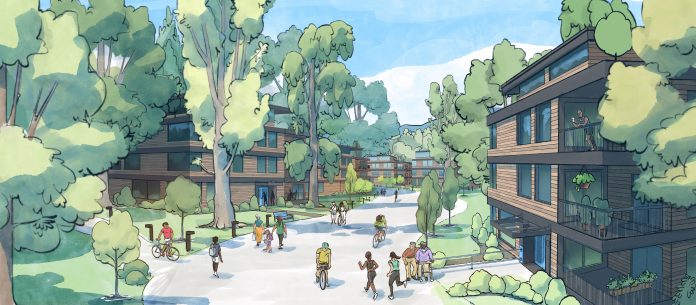
One year into master plan and environmental review, the real activity is among volunteers offering a new direction for the Talaris site in Northeast Seattle.
No progress has been made on permits or environmental review in the year since Seattle’s Department of Construction and Inspections held its last public comment session about the proposed development of Talaris, the wooded 18-acre former research institute site near Seattle Children’s Hospital in the Northeast sector of the city.
The last opportunity the public had to comment on a proposal to build 65 new single-family detached homes was September 15, 2020. At that meeting, SDCI was accepting comments on scoping for an Environmental Impact Statement (EIS). The agency received hundreds of comments asking them to reconsider the permit that would authorize the removal of hundreds of trees and replace them with an exclusive enclave.
The EIS was supposed to have a draft review within 5 to 7 months. Now a full year later, there has been no movement on the site or the proposed development under its master permit application. Additionally, there are $39,063.10 in unpaid fees on the application, with no invoices paid since April 2021. On October 1, 2021, the applicant did submit a “Certificate of Approval” to the Seattle Landmarks Board, but no date has been set for a meeting. The site itself is gated, sealed to the public, and falling into disrepair.
While the developer has been sitting on their hands, Affordable Talaris has been busy. The volunteer group of Seattle neighbors has been meeting with elected officials and local agencies to discuss alternatives to sprawling suburban development inside the City. The group welcomed guest speakers from the Thornton Creek Alliance and the Seattle Audubon Society and worked with other organizations to build coalitions preparing for the upcoming comprehensive plan rewrite. It’s vital work as Seattle prepares to elect a new mayor who will have immense power over the next 20 years of the city’s development.
Affordable Talaris also organized two design charrettes. Held in January and April, these meetings allowed members of the team’s Design Group to present three focused alternatives for the site: tree preservation, history, or housing. In stark contrast to the dull, detached boxes proposed by the Talaris developer, Affordable Talaris worked to respond to the actual situation on the ground and the needs of a changing city. During those sessions, the team took comments from a panel of architects and urban planners who spent their free time envisioning a better future for the 18 acre site. (I was permitted to attend with the promise I sit quietly in the back and not smoke.)
WHAT IF…?
What if the Talaris design goes forward as its owners currently propose? Essentially Ultron wins. A giant, faceless (tree) murderbot comes in and takes out most of the site’s vegetation to sculpt Talaris’ historic landscape into front yards for 65 individual lots. We’ve called the proposal an “unmitigated disaster” because it locks the site into another 50 years of the same kind of polluting sprawl that’s rendering the world uninhabitable (like Ultron). The property is shredded apart into single family tracts, each owning parts of the private streets to boost the allowable size of the house, thus skirting the City’s so called “McMansion ban,” which places limits the size of new single family homes. Those streets are expected to be controlled by a homeowners association that only has 65 members and thousands of feet of asphalt to repair and replace. The owners want to hack into environmentally sensitive and historic areas to remove trees and sequester an eagle’s nesting area into the smallest community parcel possible. It’s really a dreadful plan (as most of Ultron’s tend to be).
For an upfront comparison between what’s currently proposed and the Affordable Talaris Design Group schemes, here are some of the improvements at the broadest scale, put together in a handy chart. Given the constraints of early conceptual plans, their estimates on tree removal and units are approximate, but it shows how the existing proposal fails across the board.
| Existing Proposal | Scheme 1 – Landmark Preservation | Scheme 2 – Saving Trees | Scheme 3 – Density Focused | |
| Trees Removed | 271 | 44 | 14 | 62 |
| Proposed Units | 68 | 640 | 660 | 1,080 |
| Historic Demolition | Building E – Lodge Building F – Offices | None | Buildings A, B, C – Apartments Building E – Lodge | Buildings A, B, C – Apartments Building E – Lodge Building F – Offices |
| Connections | HOA maintained path at 40th Ave NE | Pedestrian path at 40th Ave NE | Street connection at 40th Ave NE | Streets at 38th Ave NE, 40th Ave, NE Pedestrian pathway to Yesler Swamp |
| Who Wins? | Ultron | Captain Carter | Groot | Spider-Man (web anchors, affordable house for Aunt May) |
What if the Talaris design considered landmark preservation?
The Talaris Conference Center and site is a registered Historic Landmark with the City of Seattle. The site received the designation because it “integrates a modernist landscape design and master plan by Richard Haag Associates with modernist buildings designed by NBBJ.” So, instead of just façadism, Talaris is historic because of both the buildings and the landscape they are surrounded by.
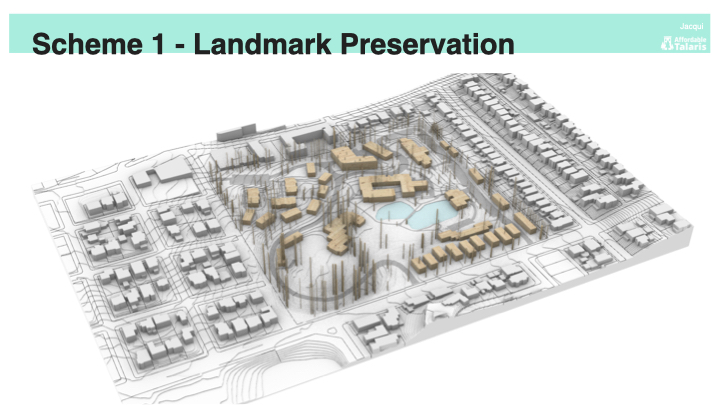
Affordable Talaris’ presentation slide for landmark preservation – 3D render of possible building arrangement 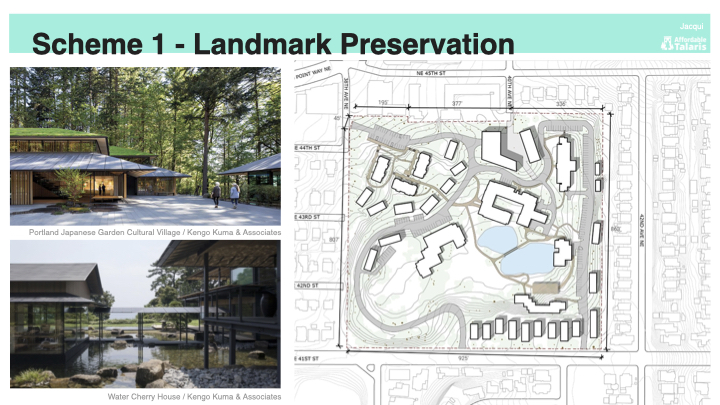
Affordable Talaris’ presentation slide for landmark preservation – layout with design inspiration 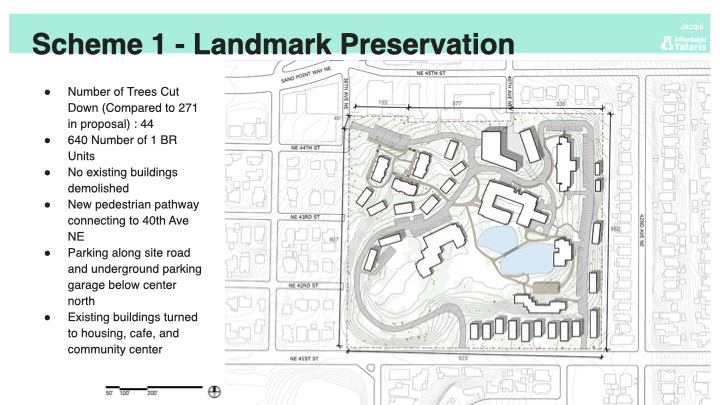
Affordable Talaris’ presentation slide for landmark preservation – layout with statistics
Taking cues from the actual site and similar buildings from that time, the Design Group put together a proposal that would preserve all the existing buildings and the focal points they surround. The team imagined new uses for the preserved structures, transforming the conference center to a community center and the hotel into housing. The existing apartments in the northwest corner would be joined by similar units to create a strong cluster. New buildings along 40th Avenue NE would surround a pedestrian courtyard from the north side and work with the historic buildings at that corner. Building along the southeast would more reflect the residential lots abutting that side of the site.
What if the Talaris design considered saving trees?
In addition to the historic designation, the Talaris site is impacted by several ecological features, including a slope extending from north to southwest. The Design Group did research on daylighting Yesler Creek, taking the waterway out of its current underground pipe and opening it as an amenity and natural resource. Unfortunately, (and to some disappointment) the feasibility of such a plan just is not there at the moment due to funding and departmental inertia. However, because the design does not envision dividing the Talaris property up into individual lots, future daylighting of Yesler Creek remains a possibility. So the Design Group focused on preserving as many trees as possible, which had the added benefit of keeping development out of the most impacted land in the southwest corner of the site.
That southwest corner of the site is vital. The current green space and trees hide the fact it is actually a wetland. The strange intersection of 41st Street and Surber Drive at that corner also conceals how connected the site could be to the Union Bay Boglands and Natural Area just on the other side of the roadway. The Design Group’s work to preserve trees on the Talaris site extends the Union Bay green space into the Talaris site, an absolute departure from the golf course lawns currently proposed.
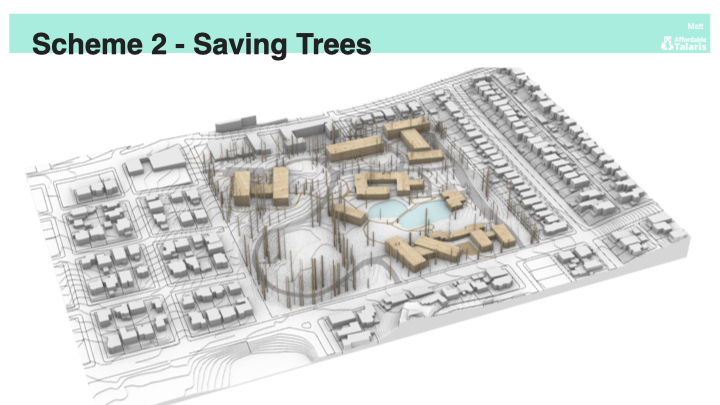
Affordable Talaris’ presentation slide for saving trees – 3D render of possible building arrangement 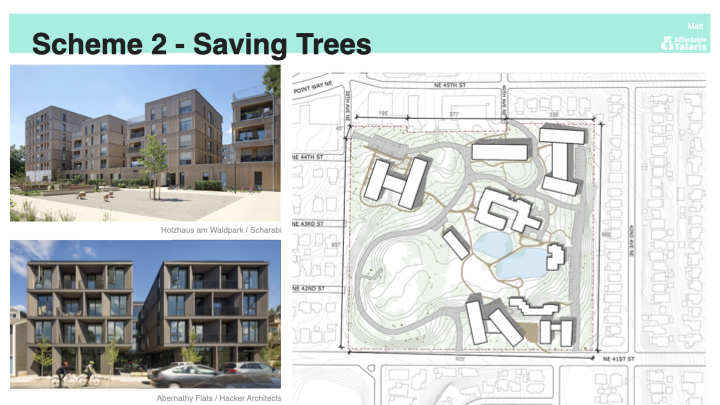
Affordable Talaris’ presentation slide for saving trees – layout with design inspiration 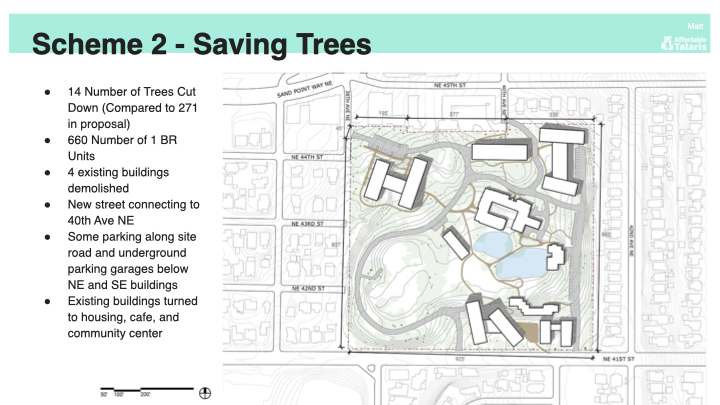
Affordable Talaris’ presentation slide for saving trees – layout with statistics
The development sites included in their design focus on the areas already impacted by buildings between the site’s existing roads. Four historic buildings would go, replaced by more significant structures, while the proposed street pattern removes a lot of the site’s current surface parking and puts together a smarter network of roads and walking paths. What’s interesting about this plan is how well it could mesh with the co-op and communal living arrangements that haven’t quite arrived in the United States yet, like baugruppen, which means “building groups” in German and refers to a type of co-housing that has taken off in parts of Europe. It helps that the team used some baugruppen concepts for design cues, allowing for the designs to question how we want to live, and whether we need to be dependent on cars and multi-million dollar mortgages to shelter in Seattle. The evocative schemes resoundingly say “no.”
What if the Talaris design considered focusing on density?
Nothing about the current Talaris proposal centered on 65 single-family detached home considers density. The surrounding city, however, does. The walkscore on the northwest corner of the Talaris site is 82, meaning most errands can be accomplished on foot. However, at the opposite corner of the site, the walkscore plummets to 62, keeping most people in their cars. With the incredible amenity of the Burke Gilman Trail right across Sand Point Way, two light rail stops within a mile and a half, and every bit of necessary shopping over at University Village (except a movie theater), the Talaris site is an urban location.
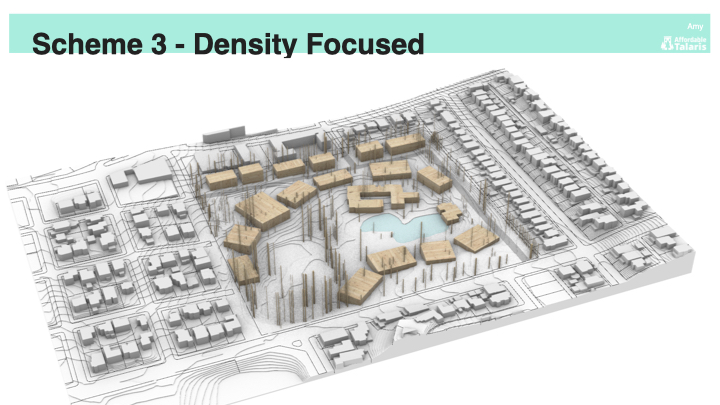
Affordable Talaris’ presentation slide for density focus – 3D render of possible building arrangement 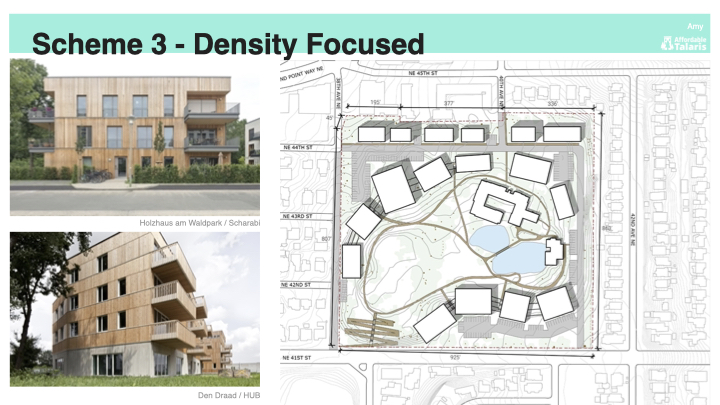
Affordable Talaris’ presentation slide for density focus – layout with design inspiration 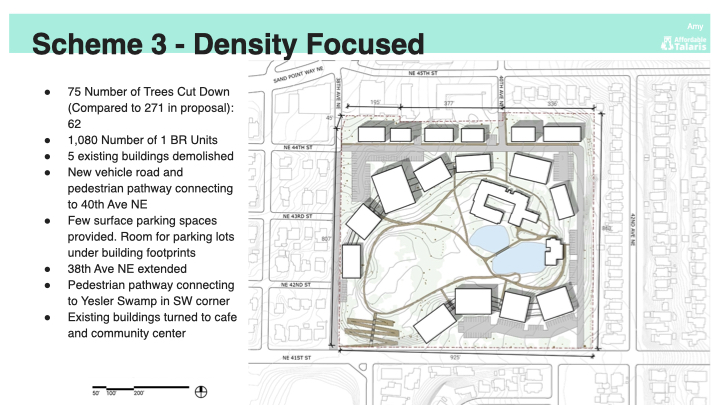
Affordable Talaris’ presentation slide for density focus – layout with statistics
The Design Group’s third proposal focused on density recognizes we are in a climate emergency, a housing emergency, and an affordability emergency. Instead of leaving the best parts of the Talaris site as an enclave accessible to the very few, the team crafted a strategy to maximize density. The proposal is not all towers, however, as the team recognized the unique shape of the whole property and used it to their advantage. The pond, plantings, and curvilinear design of the landscape that won the site historic preservation are all preserved, even if some of the smaller buildings are not, a design that allows the buildings to step down across the landscape.
Given the opportunity to vote between the three options, I would ask to split the question. Talaris is unique because it is an open piece of property at the hinge of growing density along Sand Point to the north and neighborhood residential along 41st Street to the south. The density options for Scheme 3 are perfect along the north half of the site, potentially stopping north of 43rd Street. Apartments and condos can back up to existing buildings and the maximum number of units can look into the large cluster of saved trees and preserved historic buildings. Smart design of the new buildings closest to the open space can reflect the site’s natural beauty, while maximizing the amount of people who have the opportunity to live close to it.
Along the south, I really like the smaller units and large southwest buffer of the Scheme 1 – Landmark Preservation option. Plus it adds housing on both sides of the new street on the east side of the property. No reason to pour asphalt if it’s only half used. I’m undecided about how much some of the new buildings’ designs need to reflect exactly the modernist historic buildings. To be honest, the smaller units put me in mind of accessory unit courtyards or – are you ready? – the famous Singles’ Coryell Court apartment building in Capitol Hill. It’s not like such things were never built in Seattle before. Imagine if they could be again.
What if Talaris made Seattle better?
And that’s the real success of the work that Affordable Talaris has done. They’ve offered outreach in the face of closed development processes, creativity in the face of skull wrenching tedium, options in the face of monotony. During the past year, this team of volunteers has come up with real opportunities for what could go on the site that respects Talaris’ ecology, history, and future. Their work proposes multiple ways to get to a better end result.
In contrast, the current Talaris proposal is a one-size-fits-all plan. Have land, will build McMansion. An over-mortgaged and over-parked pile of rooflines overlooking bulldozed trees and other McMansions, accessible to a privileged few. Just like that application locked up in some EIS purgatory, the suburban sprawl it proposes is locked in a past of private streets, gated enclaves, and two-car garages. It’s a wheezing past, probably because of all the trees it chops down.
Instead of withering climate arson and monotone housing only for the privileged, Affordable Talaris’ three schemes show understanding, respect, and creativity for the site and the city that surrounds it. We’ve learned that one-size-fits-all housing really only means one-size-for-the-wealthy. Seattle is rejecting that approach on many different fronts. It needs to reject McManions in city limits once more, and completely discard the current Talaris application. If they decide to make any moves, the owners can come back with a proposal that reflects some or all of the well conceived and truly visionary concepts put together by Affordable Talaris. An affordable Talaris is the cornerstone of a better Seattle to come.
Ray Dubicki is a stay-at-home dad and parent-on-call for taking care of general school and neighborhood tasks around Ballard. This lets him see how urbanism works (or doesn’t) during the hours most people are locked in their office. He is an attorney and urbanist by training, with soup-to-nuts planning experience from code enforcement to university development to writing zoning ordinances. He enjoys using PowerPoint, but only because it’s no longer a weekly obligation.


